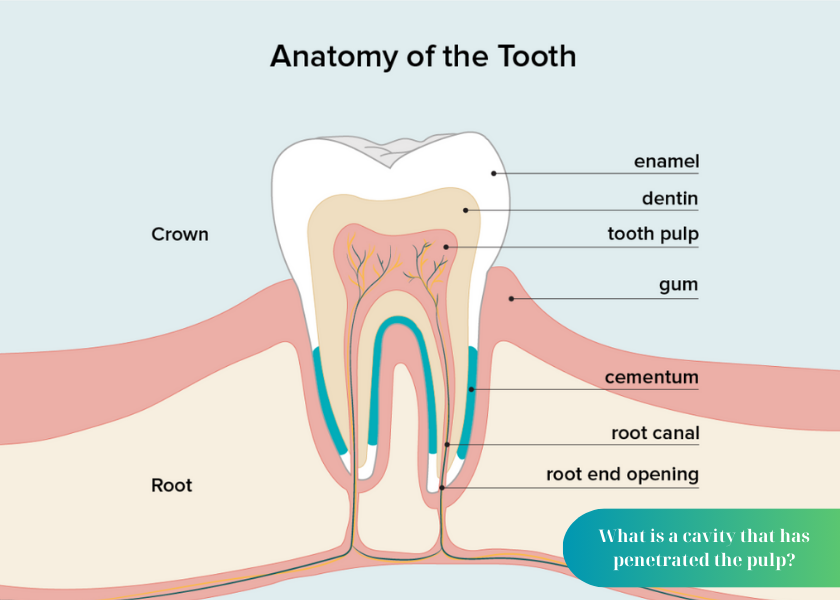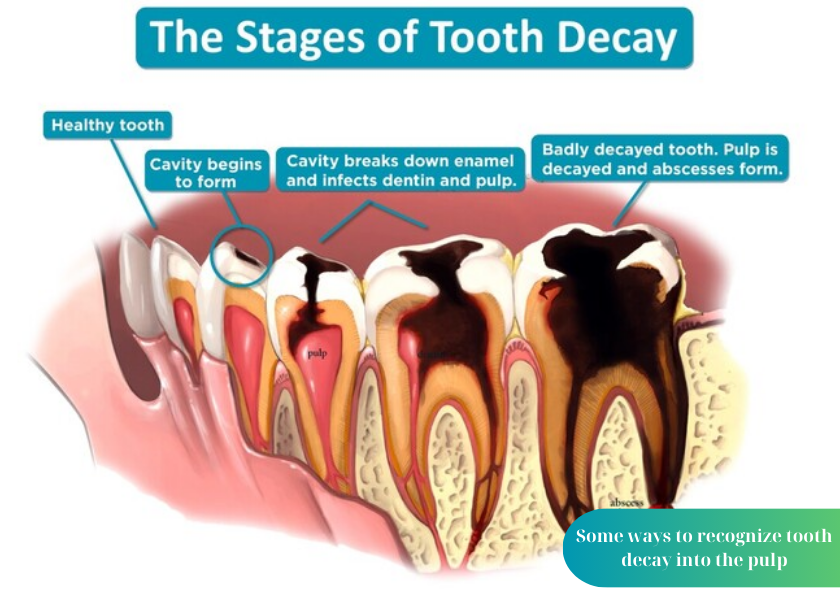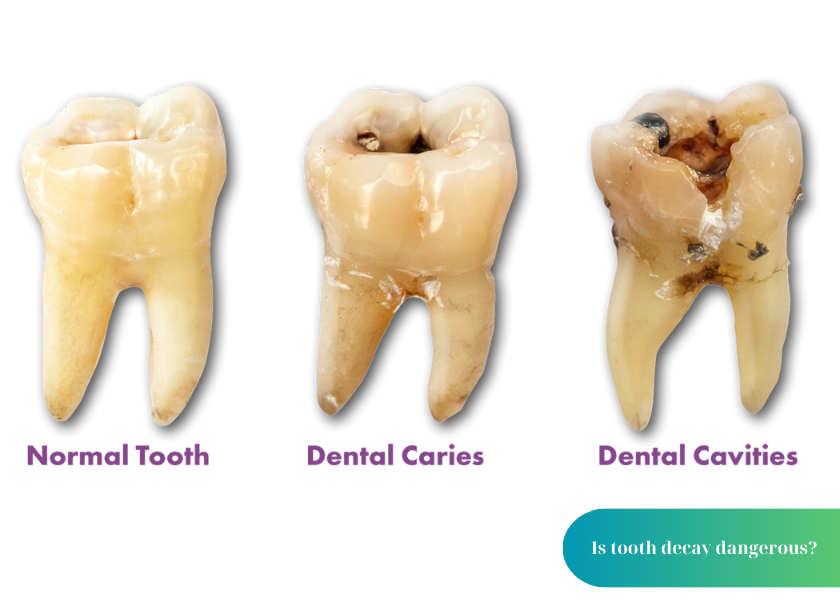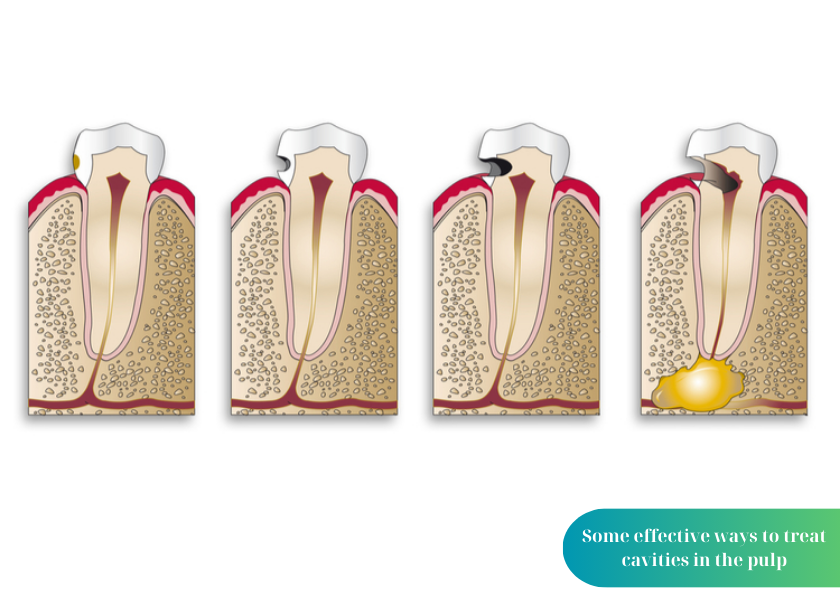Some effective ways to treat cavities that have penetrated the pulp: A cavity that has penetrated the pulp is a serious condition, when the cavity has spread to the pulp, causing severe damage. If not treated promptly, damage to the pulp can adversely affect oral and general health. Let’s learn about the signs of cavities that have penetrated the pulp and effective treatment methods with BeamDental.
Tư vấn chuyên môn bài viết:
BÁC SĨ DƯƠNG THỊ THÙY NGA
What is a cavity that has penetrated the pulp?
The tooth is made up of three main parts:
- The crown of the tooth: The opaque white part, you can see it clearly with the naked eye.
- The root of the tooth: Hidden under the jawbone, you cannot see it.
- The middle of the tooth (pulp): Where blood vessels and nerves move inside the tooth.
The crown of the tooth consists of many layers:
- Enamel: The outermost layer, quite brittle.
- Dentin: The second layer, located under the enamel.
- Pulmon: The innermost layer, including the pulp chamber in the crown of the tooth and the root canal in the root.

Tooth decay occurs when bacteria penetrate the enamel and dentin, causing tiny holes in the tooth surface. If left untreated, these holes will continue to grow, leading to larger cavities. Bacteria can penetrate deeper into the tooth’s pulp, causing pulpitis.
If a cavity that has penetrated the pulp is not treated properly, it can not only affect your oral health, but can also negatively impact your overall health. Pulpitis can cause pain, inflammation, and in severe cases, can lead to widespread infection.
See more: 6+ effective ways to treat tooth decay
Some ways to recognize tooth decay into the pulp
Stage 1:
- You feel toothache when chewing warm or cold food, when whistling, or when the weather changes.
- Toothaches appear suddenly.
- You should avoid biting food with the decayed tooth area.
Stage 2:
- If not treated promptly, the pain will last longer and become stronger.
- The pain can spread from the decayed tooth area to surrounding areas.
- You may have a headache with toothache, this condition often occurs throughout the day and becomes worse at night.
- Toothache makes it difficult to eat and drink, affecting digestion.
- This is a symptom of pulpitis.

Stage 3:
- If pulpitis is not treated early, the pulp will be damaged and you will no longer feel toothache.
- Your mouth will have a bad smell due to food stuck in the cavity.
- Gingivitis can occur and spread to other teeth.
- Teeth can become loose or broken due to tooth decay, causing bleeding gums.
- White spots on the cheeks can develop into pustules, causing facial swelling.
- You may feel mild or no pain.
- Early recognition and prompt treatment of these stages of tooth decay are important to avoid serious complications and protect your oral health.
- Some complications when tooth decay penetrates the pulp
- Pulmonary inflammation
- When a cavity penetrates the pulp, it creates deep wounds, food easily sticks to the pulp causing inflammation.
- Bacteria spread into the pulp, creating inflammatory fluid and causing pain.
- Particles of food stuck to the tooth collide with the pulp, making the pain worse.
- Gingivitis spreads
- Gingivitis will quickly spread to neighboring teeth, causing dry mouth and swelling and pain.
- Bone marrow destruction
- Tooth decay spreads, destroying the bone marrow at the tooth root, causing the tooth to lose its chewing function.
- Chewing force is reduced, food is not ground thoroughly, affecting overall health.
- When tooth decay penetrates the pulp, the tooth body is completely damaged, the tooth root can no longer be held.
- Infection at the tooth tip
- If not treated promptly, the infection will spread to the tooth tip, creating a large pus pocket causing swelling of the face and abscess of the tooth body.
- The tooth is loose, at risk of falling out.
- If the condition persists, the abscess will spread to the lower teeth, and early treatment is needed to avoid tooth loss.
- Jawbone damage
- Uncontrolled infection will destroy the jawbone, causing bone fractures.
- Damage to nerves and blood vessels, causing serious health effects.
Timely recognition and treatment of signs of tooth decay and pulpitis is very important to protect oral health and avoid serious complications.
See more: Experience in identifying types of dental bridges and 7+ things you need to know
Is tooth decay dangerous?

When a tooth decays into the pulp, this is a dangerous condition and needs to be treated immediately to avoid serious consequences such as:
- Broken tooth and pain:
A tooth that has decayed into the pulp will gradually weaken and break easily.
The patient will feel severe pain, especially when eating and drinking.
- Dry mouth and swollen gums:
Tooth pulpitis causes dry mouth.
The gums are swollen and bleed easily when touched.
- Apical abscess:
Apical abscess causes severe pain, affecting daily activities and health.
- Complete tooth loss:
If not treated promptly, tooth decay into the pulp can lead to complete tooth loss.
- Inflammation of the tooth socket:
Bacteria invade and cause inflammation of the posterior tooth socket, causing the inflammation to spread.
- Jaw joint infection:
Pulmonary infection can spread to the jaw joint, causing inflammation and pain.
- Radicular cysts:
Dental decay into the pulp creates cysts in the tooth root, destroying the jaw bone structure.
This causes serious complications, affecting the ability to work and quality of life.
- Risks with other diseases:
Patients with cardiovascular disease, diabetes, … are at risk of the disease becoming more severe and difficult to recover when bacteria penetrate the pulp.
It is important to detect and treat pulpal decay as soon as possible to protect oral and general health.
See more: What is a dental bridge? and 5+ information you need to know
Some effective ways to treat cavities in the pulp
If you detect tooth decay early, you need to see a dentist for treatment as soon as bacteria begin to invade the pulp. Below are the most common methods of treating cavities in the pulp today:
Root canal treatment
Root canal treatment process:
- Anesthesia: The doctor will start by anesthetizing to ensure you do not feel pain during the treatment.
- Drilling the pulp chamber: Next, the doctor will drill into the pulp chamber to access the infected pulp.
- Removing infected pulp: The doctor will remove all infected pulp from the pulp chamber and root canal.
- Root canal filling: After cleaning the root canal, the doctor will fill the root canal with specialized substances to prevent bacteria from re-entering.
- Tooth restoration: The decayed or chipped root will be restored with other dental methods such as fillings or porcelain crowns to fix and restore chewing function.
Apical root resection
Apical root resection is one of the effective ways to treat cavities in molars, especially when the pulp is severely infected. Here is the treatment process using this method:
- Anesthesia: The doctor will start by anesthetizing the area to be treated so that you do not feel pain during the procedure.
- Incision of the gums and cutting of the bone: The doctor will make an incision in the gums and cut a part of the bone to access the tooth apex and the infected area.
- Removal of the tooth apex and the infected area: After reaching the tooth apex, the doctor will remove the entire tooth apex along with the infected area to prevent bacteria from spreading.
- Root filling: The root will be filled with a non-occlusive material to protect the tooth from bacterial invasion.
- Artificial bone filling: The cut bone will be filled with artificial bone to support the bone structure and help stabilize the tooth.
- Mucosal Patching: Finally, the incised gum mucosa will be patched to protect the treated area and help the gums recover quickly.
Tooth extraction
If pulpitis is not treated promptly, you may need to have your tooth extracted to prevent the infection from spreading. Here are the steps and notes during the tooth extraction process due to severe pulpitis:
- Anesthesia: The doctor will inject anesthetic to reduce pain and help you feel more comfortable during the tooth extraction process.
- Tooth Extraction: With modern tooth extraction methods and techniques, the doctor will safely extract the infected tooth and remove the entire inflammation at the root of the tooth.
- Post-tooth extraction care: After tooth extraction, you need to follow your dentist’s instructions for the wound to heal quickly. This includes maintaining oral hygiene, avoiding eating hard, hot or spicy foods, and taking medication as prescribed by your doctor.
- Get new teeth: After the wound has healed, you can get dentures or dental implants to fill the space of the extracted tooth, helping to restore chewing function and aesthetics of the teeth.
See more: Do braces require tooth extraction? 5+ things you should know
Some ways to prevent tooth decay

To prevent tooth decay from penetrating deep into the pulp, you need to practice proper oral hygiene according to the following steps:
- Brush your teeth properly: Use toothpaste containing fluoride and brush your teeth at least twice a day. Use dental floss to remove plaque and food debris stuck between your teeth.
- A reasonable diet: Limit fast food, carbonated soft drinks, sour foods and sweets to avoid damaging tooth enamel. Supplement calcium and essential minerals to keep teeth strong.
- Use the right toothbrush: Use a toothbrush containing fluoride to protect tooth enamel and prevent tooth decay.
- Regular dental check-ups: Visit your dentist every 6 months to promptly detect and treat dental diseases, especially tooth decay.
- Early treatment when there are signs of toothache: If you feel toothache, see your dentist immediately for timely treatment to prevent the condition from getting worse.
If tooth decay is diagnosed and treated early, it will help reduce pain and maintain oral health. If tooth decay spreads to the pulp, go to the dentist immediately for timely diagnosis and treatment to prevent damage to the entire jaw.
BeamDental – High-quality dentistry
BeamDental is proud to be a reputable dental address with many years of experience. We are highly appreciated by customers for the quality and effectiveness in examining and treating oral diseases. With a team of professional doctors and modern equipment, BeamDental is committed to bringing a painless and safe treatment experience to customers.
The above article by BeamDental has compiled complete information about the causes, symptoms and ways to treat cavities. BeamDental hopes this information will be useful to you. If you have questions about dentistry and need advice, please contact the hotline to receive free advice directly from the dentist!
See more: Should porcelain crowns be used with braces? 5+ things you should know
BEAMDENTAL – HỆ THỐNG NHA KHOA TIÊU CHUẨN HÀNG ĐẦU
CHI NHÁNH HÀ NỘI
CS1: 7B Thi Sách, Ngô Thì Nhậm, Hai Bà Trưng, Hà Nội - 0934.61.9090
CS2: 98C Chiến Thắng, Văn Quán, Hà Đông - 0934.61.9090
CHI NHÁNH TP.HỒ CHÍ MINH (HCM)
56 Nguyễn Đình Chiểu, Đa Kao, Quận 1, Tp.Hồ Chí Minh - 0766.00.8080
GIỜ HOẠT ĐỘNG:
09h00 – 21h00. Tất cả các ngày trong tuần
Link web: beamdental.com.vn



